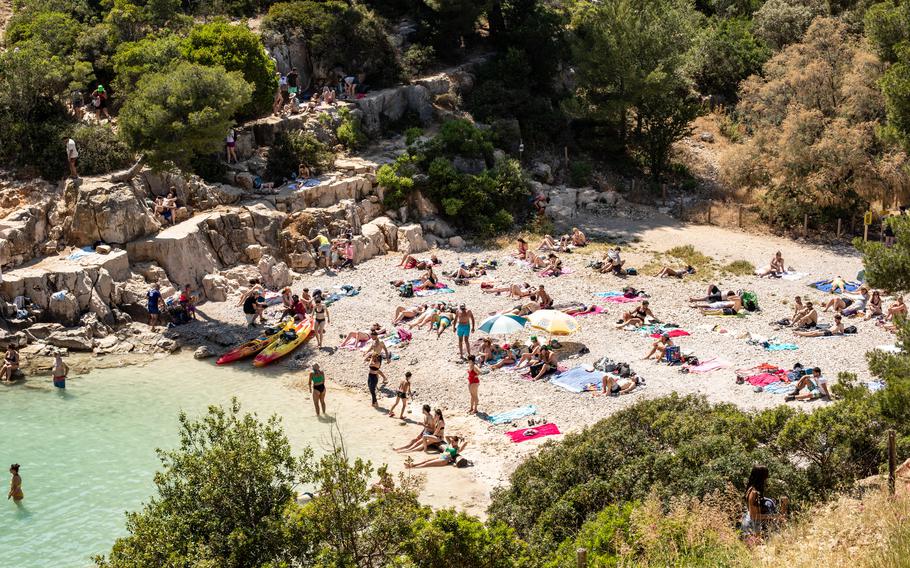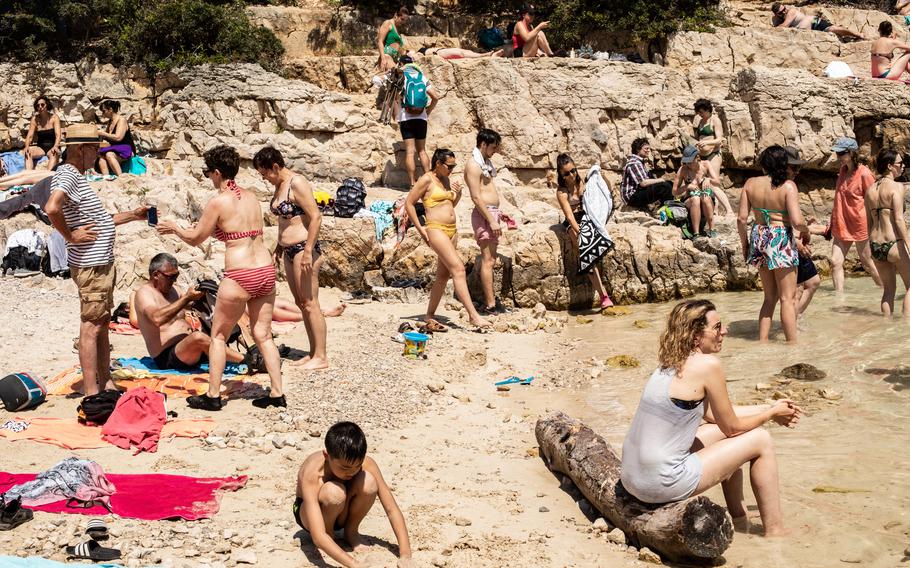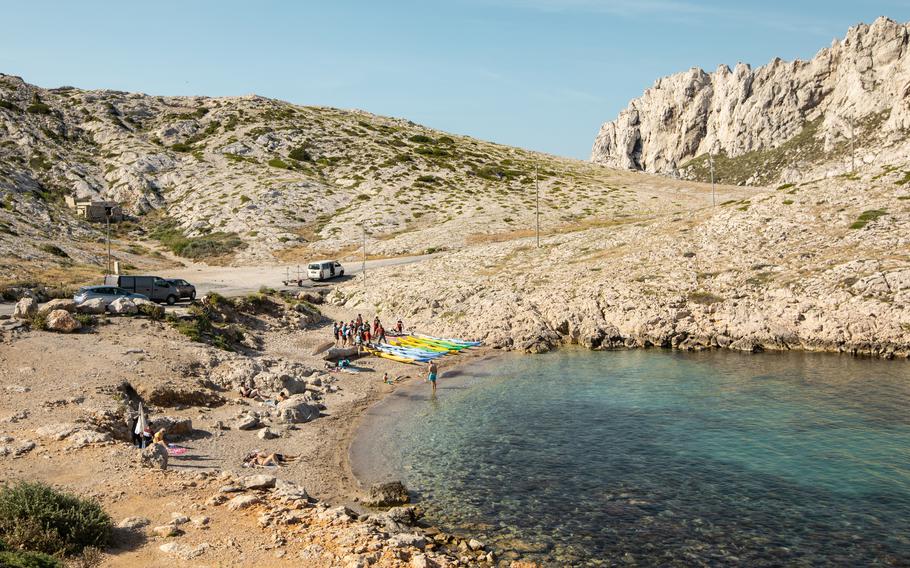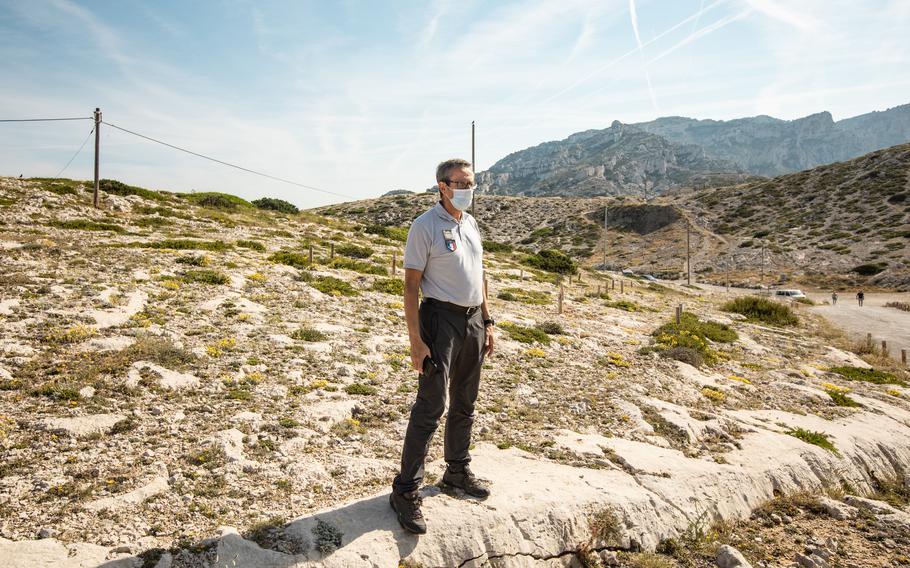
People rest on a beach in the National Park of Calanques, France, on June 12. (Sandra Mehl/The Washington Post)
In one of Europe’s most picturesque national parks, officials have embraced a surprising goal: They want to make the site appear less stunning.
Standing next to wind-bent pine trees reflected in the turquoise water of the Mediterranean on a recent day, Calanques National Park ranger Alain Vincent did his best to talk the place down. There are too many people and no trash cans, he said, indicating the beach packed with swimmers and sunbathers taking selfies with their dogs.
Every beautiful photo of this bay, Vincent said disapprovingly, is one too many.
As tourism professionals around the world eagerly await the return of visitors, Calanques, in southern France, has a different message: Please, most of you, stay away.
Except during lockdowns, the coronavirus pandemic did not stop people from coming here; in fact, restrictions on foreign travel prompted a surge of domestic arrivals. The park’s caretakers say the burgeoning crowds, on the beaches and in the water, threaten the site’s sensitive biological equilibrium.
In response, they have forged ahead with an initiative that many other European destinations considered before the pandemic but few acted on: a “de-marketing” campaign aimed at reducing the number of visitors the park attracts.
To that end, officials have begun asking Instagram influencers to take down photos of Calanques’ picturesque bays. The park’s website advises that the water is often cold and the beaches are “difficult to access, cramped and invaded by crowds.” Upon arrival, visitors may soon face a ticketing system.

People rest on a beach in the National Park of Calanques, France, on June 12, 2021. (Sandra Mehl)
The changes will likely please locals and some of the rangers, who have long wanted to see nature lovers rather than swimmers and yachtsmen, more people who are mindful of biodiversity and fewer binge drinkers, more who are interested in the growth patterns of pine trees and fewer who want to jump off tree branches into the sea.
“It is, in some ways, a pioneering effort,” said Jürgen Schmude, a researcher at the University of Munich. “Other destinations have to get there, too.”
As the world’s top international tourism destination, France has in recent months prioritized such moves to balance a recovery of the industry with strides toward greater sustainability. In parts of southern France, for example, a popular GPS navigation software has been programmed to suggest alternatives to overcrowded top destinations.
“The crisis has certainly accelerated the thought process,” France’s junior minister in charge of tourism, Jean-Baptiste Lemoyne, said in an interview. The pandemic has caused “a lot of distress,” he said. “But this is also a moment of reinvention - we must not miss out on it.”
Experts worry, however, that despite the changes underway in southern France and other places, some of the European destinations most affected by overtourism are lagging behind. They say that barring a major resurgence of the coronavirus, overcrowding could again become a problem on the continent as early as this summer, as Europeans embark on annual vacations and vaccinated Americans are welcomed.
“Many people can’t wait to get on a plane again,” said Jeroen Klijs, a professor at Breda University of Applied Sciences researching the social impacts of tourism. “It’s almost like revenge tourism - people want to get their holidays back.”
Jan van der Borg, a tourism management and applied economics researcher affiliated with multiple institutions, said that major tourist draws such as Venice and Prague have largely failed to recognize the pandemic as an opportunity for more sustainable models. Cruise ships have returned to Venice, Prague’s notorious bar crawls are back, and budget airlines have resumed touting deals.
“I’m quite disappointed,” van der Borg said.
Still, while many hotel and restaurant owners would be pleased to see a surge in arrivals, tourists may meet more local resistance than in the past.
As Venice’s canals emptied of traffic, encouraging dolphins to return, and the streets of Amsterdam were reclaimed by locals last year, many wondered what it would take for it to stay that way.
“Suddenly, residents meet again on the street, drink a cup of coffee together on the sidewalk,” Amsterdam residents wrote in a petition last summer for a ban on holiday rentals and other measures. “It’s actually bizarre that these normal neighborhood scenes feel strange.”
In Venice recently, authorities launched a competition for ideas on how to keep cruise ships and other large vessels away from the historical city center, after years of complaints that the ships are damaging the foundations of buildings. UNESCO recently said Venice may be put on its list of endangered world heritage sites unless action is taken.
In Calanques, Vincent, the ranger, can spot the impact of overtourism from miles away. From a hilltop overlooking the national park, he pointed to a bay below that was once encircled by dense stands of pines.

Visitors settle in for the day in the National Park of Calanques, France. (Sandra Mehl)
“The pine trees gradually disappear. There are almost none left,” he said, blaming erosion caused by visitors.
“The destruction of the natural habitats can be irreversible,” cautioned Zacharie Bruyas, who is responsible for the park’s communications.
Calanques has long attracted visitors, though historically on a more manageable scale. But as the nearby city of Marseille became increasingly popular in recent years, the park saw visitor numbers rise, too. Widely shared posts on social media drew more.
Laurent Lhardit, Marseille’s deputy mayor for the economy, described the influx of tourists last year as close to an “explosion,” overwhelming the city and the adjacent national park.
Officials hope that better crowd control will also benefit visitors and allow them to have a better experience. Some may discover new areas, such as the hilltop offering a panoramic - and peaceful - view of the white rocks, steep cliffs and green trees below.
The beach was “beautiful,” said Yasmine Bounguab, 24, while leaning against a rock with a friend. But the crowds were too much for them.
“We had to go somewhere else,” she said.
For Schmude, the University of Munich researcher, the most promising trend in efforts to combat overtourism may be a change in consumer behavior. “A part of the population will travel more consciously,” he said, predicting fewer plane journeys and higher ticket prices as a result.

Alain Vincent, a national park officer, in the National Park of Calanques, France. (Sandra Mehl)
Klijs, the Dutch researcher, agreed that after an initial period of what he called revenge tourism, questions raised during the pandemic could prompt a rethink. But he warned that leaving the debate up to consumers and the tourism industry will not be sufficient.
Government officials should embrace this moment to “get people to reconsider,” he said.
Calanques National Park may serve as an example that change is possible - but it won’t happen overnight. As Vincent and his colleagues move around the park by speedboat or car, they encounter rule violators wherever they look, from parking offenders to fishermen threatening them with violence.
“It takes time,” he said. “What’s needed is a change of mind-set.”